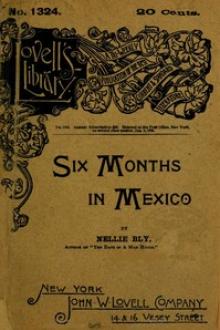Six Months in Mexico by Nellie Bly (best classic literature TXT) 📕

- Author: Nellie Bly
- Performer: -
Book online «Six Months in Mexico by Nellie Bly (best classic literature TXT) 📕». Author Nellie Bly
CHAPTER VIII.
A MEXICAN BULL-FIGHT.
Mexicans are always manana until it comes to bull-fights and love affairs. To know a Mexican in daily life is to witness his courtesy, his politeness, gentleness; and then see him at a bull-fight, and he is hardly recognizable. He is literally transformed. His gentleness and “manana” have disappeared; his eyes flash, his cheeks flush - in fact, he is the picture of “diabolic animation.” It is all “hoy” to-day with him. Even the Spanish lady of ease and high heels forgets her mannerisms and appears like some painted heathen jubilant over the roasting of a zealous missionary.
There have been some very good bull-fights lately in the suburbs, for fighting is prohibited within a certain distance of the city. When they say a good bull-fight, it means that the bulls have been ferocious and many horses and men have been killed.
It is safe to say that the majority of Americans who visit Mexico do like the natives, even on the first Sunday; attend divine service in the morning, a bull-fight in the afternoon and theater in the evening. But it is with regret that I say that many Americans who are residents of the city now are as passionately fond of the national inhuman sport as a native who has been reared up to it. Some never miss a fight, and their American voice outstrips the Mexican in the shouts of “bravo” at the bloody thrusts. Yet there are tourists who cannot outsit one performance, and have no desire to attend a second. While we Americans cry “brutal” against the national amusement, they in return cry “brutal” to our prize-fights, in which they see nothing to admire, and a dog-fight is beneath their contempt.
“Your humane societies would prevent bull-fights in the States,” said a Spanish gentleman; “your people would cry out against them. Yet they have strong men trying to pound one another to death, and the people clamor for admission to see the law kill men and women, while in health and youth, because of some deed done in the flesh. Yes, they witness and allow such inhuman treatment to a fellow mortal and turn around and affect holy horror at us for taking out of the world a few old horses and furnishing beef for the poor.”
Read of glorious bull-fights and then witness one, and the scene is entirely changed. The day of their glory has departed. When Maximilian graced the country with his presence the fights were indeed fitted for royal sight. The costumes were of the costliest material; the horses were of the best blood and breed, and the bulls regular roaring Texans, which needed no second sight of a red capa to raise their feverish ire. No fight cost less than $5,000.
Now all is different. Maximilian lies in a grave to which a treacherous bullet consigned him; Carlotta, still what that bullet made her, a raving lunatic and a widow. Men of low degree are permitted to grace the fights, which are but miserable shadows, a farce of the former royal days.
The National - a narrow gauge - and the Mexican Central, run special trains consisting of twenty and twenty-five cars, first, second, and third-class, to the fights every half hour. Tickets are sold during the week, which include railroad fare, admission to grounds and seat. Long before the time for leaving, carriages pull up to the stations and blooming senoras, fair senoritas, handsome senors and delicate, lovely children, dressed in the height of wealth, and fashion, enter the railway coach and proceed to make themselves comfortable for the half-hour or hour’s ride which is to bring them to their destination. Bands march up and are disposed of in the coaches, and last comes a troop of soldiers, clad in buckskin suits, elaborately trimmed with silver ornaments, yard wide sombreros, and armed with gun, revolver, sword, dagger, mace, and lasso, which they have no hesitation in using in quite a characteristic manner, asking no questions, expecting no information, performing their duties fatally.
They are the “daisies” of Mexico, and in appreciation of which they are sent to grace every bull fight! They are the best paid soldiers in the republic, receiving $1 a day, while the highest salary paid to any of the others is twenty-five cents daily, out of which they provide their own wearing apparel and food. The same “daisies” were all outlaws, bandits, fierce and uncontrollable. Their many deeds, always done in the name of the law, are fearful to relate, so the present president thought it policy to engage their services. They ride handsome horses, furnished by the government, and are said to be the most faithful, reliable men in the employ of the republic. Their only fault is killing without asking questions, for which they go scot-free without even so much as a rebuke. The “daisies” have some of the finest specimens of manhood in Mexico, and number in their list some handsome, open-faced, youthful boys. They can maintain order among 6,000 people filled with pulque without uttering one word. Their presence is sufficient.
On speeds the train. Above the din arises the musical sound of a strange language. A view from the window exhibits some of Mexico’s most beautiful scenery. Now we pass beautiful farms, magnificent artificial lakes covered with wild duck, which would delight the heart of our American hunters, as they arise in dark clouds on the approach of the train, and move off to a more secluded spot; beautiful fields of grain, and acres and acres of pulque plant, quaint huts, picturesque, historic churches, ancient monastries and convents, now used for other purposes, all surrounded by snow-capped mountains. For miles we keep our eyes on the strangest and grandest mountain in Mexico, the White Lady, or the Sleeping Virgin. It deserves chapters of description and praise, but feeling our inability to do it justice we shall confine ourselves to a brief remark.
Outlined against a blue sky, only such skies as are habitual to Italy and Mexico, is a snow-topped mountain in form of a woman lying on a straight cot; on the head is a snow band, such as worn by Sisters of Mercy. The arms are folded peacefully on the breast, and the snow garments fall in graceful folds over the feet. There she lies and has lain for centuries in perfect outline and peaceful repose. Even as we look the clouds play fantastically about the beauteous form. Now they cover her body like a dark shroud. Again they drape her cot like a pall, then rise in a threatening attitude above her fair head, but undisturbed she lies there with hands ever folded above the quiet heart, proudly indifferent to storm or shine, clad in her pure snowy garments, truly the most beauteous sight in Mexico. With a sigh we at last leave her behind and are rudely brought to earth by the announcement that we have reached our destination.
The bull ring resembles somewhat a race course; the highest row is covered and called boxes. They are divided into small squares, which are meant to hold six but are crowded with four. Miserable chairs without backs are the comfortable seats. Below is the amphitheater, arranged exactly like circus seats. Different prices are charged and the cheapest is the sunny side, where all the poor sit. A fence painted in the national colors - red, green and white - of some six feet in height, incloses the ring. Three band-stands, equal distances apart, are filled with brilliantly uniformed musicians.
The judge is appointed by the municipality, but the fighters have a right to refuse to fight under one judge whom they think will compel them to take unnecessary risks with a treacherous bull, for a judge once chosen his commands are law, and no excuse will be accepted for not obeying, but a fine deducted from the fighter’s salary, and he loses cast with the audience. The judge is in a box in the center of the shady side; with him is some prominent man, for every fight must be honored with the presence of some “high-toned” individual, while behind stands the bugler, a small boy in gay uniform, with a bugle slung to his side, by which he conveys the judge’s whispered commands to the fighters in the ring.
Below the judge hangs a row of banderillas. They are wooden sticks about two feet long with a barbed spear of steel in the end, which are stuck in the bull to gore him to madness. They are always gayly decorated with tinsel and gaudy streamers of the national colors. Sometimes firecrackers are ingeniously inserted, which go off when the banderilla is deftly fastened in the beast’s quivering flesh.
The bands play alternately lively airs, the audience for once find no charms in the music and forget to murmur manana, but soon begin to cry “El toro! El toro!” (The bull! the bull!)
The judge nods to the bugler, and as he trumpets forth the gate is swung open and the grand entry is made. First comes “El Capitan” or matador, chief of the ring, and the men who kill the bull with a sword. Next eight capeadores, whose duty consists in maddening the bull and urging it to fight by flinging gay-colored capas or capes in its face. Two picadores, who are armed with long poles, called picas, in the end of which are sharp steel spears which they fight the bull with. After come the lazadores, dressed in buckskin suits, elaborately trimmed with silver ornaments and broad, expensive sombreros. They ride fine horses, and do some very pretty work at lassoing. Three mules abreast, with gay plumes in their heads, and a man with a monstrous wheelbarrow of ancient make, close up the rear. All range before the judge and make a profound bow, after which the mules and wheelbarrow disappear.
The dresses of the fighters are very gorgeous: satin knee-breeches and sack coat of beautiful colors, and highly ornamented, beaded, etc. On the arm is carried the capa, a satin cape, the color of the suits, and little rough caps, tied under the chin, grace the head. At the back of the head is fastened false hair, like a Chinaman’s, familiarly known as “pig tail.” Two gayly painted clowns, who, unlike those in the States, never have anything to say, are always necessary to complete the company in the ring.
Again the bugle sounds, the band strikes out in all its might, the people rise to their feet and cry “El toro,” the fighters form a semicircle around a door, el capitan draws a bolt, flings it open, and as the bull springs forth from his dark and narrow cell a man perched above sticks two banderillas into his neck to madden him. With a snort of rage he rushes for the capas. As they are flirted before his eyes, he tramples them under his hoofs, and the capeadors escape behind the bourladera, a partition six feet wide, placed in the arena at four places equally distant.
At the trumpet sound a banderilla runs out waving the banderillas above his head. He faces the maddened bull with a calm smile. The bull paws the ground, lowers his head, and with a bellow of rage makes for his victim. Your eyes are glued to the spot. It is so silent you can hear your heart throb. There can be no possible escape for the man. But just as you think the bull will lift him on his horns you see the two banderillas





Comments (0)